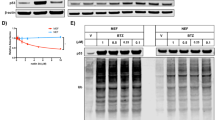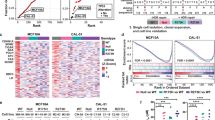Abstract
p53 is a cellular phosphoprotein of short half-life (t1/2;) which is present at elevated levels in cells transformed by various stimuli including viruses, chemicals and radiation1–5. p53 forms specific stable complexes with simian virus 40 (SV40) large-T itntigen and an adenovirus Elb protein of relative molecular mass (Mr) 57,000 (refs 4–7). A number of reports have associated p53 with cell proliferation8–11, and p53 complementary DNA expression constructs immortalize primary cells in vitro12 and render them sensitive to transformation by an activated ras oncogene12–14. We have examined the biological properties of a set of p53 expression constructs, and report here that cellular immortalization by a wild-type p53 cDNA gene is conditional upon the promoter/enhancer construction used, but that p53 can extend cellular lifespan by a second distinct mechanism involving rearrangements of the coding sequence which give rise to stable protein products. Cells immortalized by one of these mutants are refractory to subsequent transformation by a ras oncogene, indicating that cellular immortalization and ras cooperation are separate activities.
This is a preview of subscription content, access via your institution
Access options
Subscribe to this journal
Receive 51 print issues and online access
$199.00 per year
only $3.90 per issue
Buy this article
- Purchase on Springer Link
- Instant access to full article PDF
Prices may be subject to local taxes which are calculated during checkout
Similar content being viewed by others
References
DeLeo, A. B. et al. Proc. natn. Acad. Sci. U.S.A. 76, 2420–2424 (1979).
Rotter, V. Proc. natn. Acad. Sci. U.S.A. 90, 2613–2617 (1983).
Rotter, V., Boss, M. A. & Baltimore, D. J. Virol. 38, 336–346 (1981).
Lane, D. P. & Crawford, L. V. Nature 278, 261–263 (1979).
Linzer, D. I. H. & Levine, A. J. Cell 17, 43–52 (1979).
Oren, M., Maltzman, W. & Levine, A. J. Molec. cell. Biol. 1, 101–110 (1981).
McCormick, F. & Harlow, E. J. Virol. 34, 213–224 (1980).
Sarnow, P., Ho, Y. S., Williams, J. & Levine, A. J. Cell 28, 387–394 (1982).
Milner, J. & McCormick, F. Cell Biol. int. Rep. 4, 663–667 (1980).
Milner, J. & Milner, S. Virology 112, 785–788 (1981).
Mercer, W. E., Nelson, D., DeLeo, A. B., Old, L. J. & Baserga, R. Proc. natn. Acad. Sci. U.S.A. 79, 6309–6312 (1982).
Jenkins, J. R., Rudge, K. & Currie, G. A. Nature 312, 651–654 (1984).
Eliyahu, D., Raz, A., Gruss, P., Givol, D. & Oren, M. Nature 312, 646–649 (1984).
Parada, L. F., Land, H., Weinberg, R. A., Wolf, D. & Rotter, V. Nature 312, 649–651 (1984).
Kalderon, D., Richardson, W. D., Markham, A. F. & Smith, A. E. Nature 311, 33–38 (1984).
Newbold, R. F., Overell, R. W. & Connell, J. R. Nature 299, 633–635 (1982).
Ruley, H. E. Nature 304, 602–606 (1983).
Land, H., Parada, L. F. & Weinberg, R. A. Nature 304, 596–602 (1983).
Klein, G. Cancer Res. 19, 343–358 (1959).
Newbold, R. F. & Overell, R. W. Nature 304, 648 (1983).
Jenkins, J. R., Rudge, K., Redmond, S. & Wade-Evans, A. Nucleic Acids Res. 12, 5609–5626 (1984).
Harlow, E., Crawford, L. V., Pim, D. C. & Williamson, N. M. J. Virol. 34, 861–869 (1981).
Coffman, R. L. & Weissman, I. L. J. exp. Med. 153, 269–279 (1981).
Laemmli, U. K. Nature 277, 680–685 (1970).
Author information
Authors and Affiliations
Rights and permissions
About this article
Cite this article
Jenkins, J., Rudge, K., Chumakov, P. et al. The cellular oncogene p53 can be activated by mutagenesis. Nature 317, 816–818 (1985). https://doi.org/10.1038/317816a0
Received:
Accepted:
Published:
Issue Date:
DOI: https://doi.org/10.1038/317816a0
This article is cited by
-
Transcription regulation by mutant p53
Oncogene (2007)
-
Expression of p53, bcl-2 and growth hormone receptor in actinic keratosis, hypertrophic type
Archives of Dermatological Research (2003)
-
Hyperthermic induction of apoptosis in malignant fibrous histiocytoma cells: possible involvement of a p53-independent pathway in the induction of bax gene
Journal of Orthopaedic Science (2002)
-
Twenty years of p53 research: structural and functional aspects of the p53 protein
Oncogene (1999)
-
Expression of BCL-2 and p53 in oncocytic (Hürthle cell) tumors of the thyroid: An immunohistochemical study
Endocrine Pathology (1998)
Comments
By submitting a comment you agree to abide by our Terms and Community Guidelines. If you find something abusive or that does not comply with our terms or guidelines please flag it as inappropriate.



